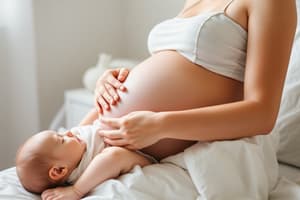Podcast
Questions and Answers
What physiological change occurs as the fetus descends further into the vagina during the expulsive phase of labor?
What physiological change occurs as the fetus descends further into the vagina during the expulsive phase of labor?
Pressure from the presenting part stimulates the Ferguson reflex, leading to the urge to push.
What is a characteristic of contractions during the second stage of labor?
What is a characteristic of contractions during the second stage of labor?
They become stronger and longer but less frequent, allowing rest periods for both mother and fetus.
What is a common emotional response during the transition phase of labor?
What is a common emotional response during the transition phase of labor?
Fearfulness, loss of control, and a belief that she cannot carry on.
What is the role of uterine retraction during labor?
What is the role of uterine retraction during labor?
What is the approximate dilation of the cervix during the transition phase of labor?
What is the approximate dilation of the cervix during the transition phase of labor?
What muscles aid in the propulsion of the baby downward during the second stage of labor?
What muscles aid in the propulsion of the baby downward during the second stage of labor?
What is a physical response of the perineum during the expulsive phase of labor?
What is a physical response of the perineum during the expulsive phase of labor?
What is the frequency and duration of contractions during labor?
What is the frequency and duration of contractions during labor?
What is the anatomical definition of the second stage of labor?
What is the anatomical definition of the second stage of labor?
What is characterized by distinctive physiological changes during the transition phase of labor?
What is characterized by distinctive physiological changes during the transition phase of labor?
During which phase of the second stage of labor does the baby's head descend into the birth canal through the pelvis?
During which phase of the second stage of labor does the baby's head descend into the birth canal through the pelvis?
What happens during the expulsive phase of the second stage of labor?
What happens during the expulsive phase of the second stage of labor?
What are some factors that can influence the duration of the second stage of labor?
What are some factors that can influence the duration of the second stage of labor?
What typically happens to the cervix at the beginning of the second stage of labor?
What typically happens to the cervix at the beginning of the second stage of labor?
What is the significance of the transition phase in the second stage of labor?
What is the significance of the transition phase in the second stage of labor?
What is the role of contractions during the expulsive phase of the second stage of labor?
What is the role of contractions during the expulsive phase of the second stage of labor?
What is the mechanism of labor, and what is the most common presentation and position at the onset of labor?
What is the mechanism of labor, and what is the most common presentation and position at the onset of labor?
What happens to the perineum and vulval opening during contractions?
What happens to the perineum and vulval opening during contractions?
What is a sign that the baby is about to be born?
What is a sign that the baby is about to be born?
What happens to the fetal heart rate during contractions?
What happens to the fetal heart rate during contractions?
What is engagement, and when does it typically occur in nulliparous pregnancies?
What is engagement, and when does it typically occur in nulliparous pregnancies?
What is a common feature of maternal exhaustion during labor?
What is a common feature of maternal exhaustion during labor?
What occurs after the baby's birth, often accompanied by a gush of liquor?
What occurs after the baby's birth, often accompanied by a gush of liquor?
What is the continuous process that occurs throughout labor until the head is born?
What is the continuous process that occurs throughout labor until the head is born?
Flashcards are hidden until you start studying
Study Notes
Signs of Progress
- Loss of control, belief that she cannot carry on, fearfulness, disorientation, nausea, demands for pain relief, need to shout and scream, slowing of contractions, and dozes are signs of transition.
- Vaginal examination typically reveals dilation between 7 and 9 cm.
Expulsive Phase
- The strength and consistency of the pushing urge varies in intensity, becoming more consistent over time.
- The woman usually makes a characteristic grunting noise at the height of the contraction.
- She may feel that her bowels are emptying.
- The perineum bulges and is stretched thin as it is distended by the descending fetus.
- The anus initially pouts and then dilates with contractions.
Physiology of the Second Stage of Labor
- Contractions occur every 2-3 minutes with an amplitude of 60-80 mmHg and last 60-70 seconds.
- Contractions, along with uterine retraction, aid in the descent of the fetus through the birth canal.
- Fetal axis pressure is exerted as the uterus contracts, aiding in the descent of the fetus.
- Pressure from the presenting part stimulates the Ferguson reflex, leading to the urge to push.
Secondary Powers
- Maternal pushing, aided by the secondary powers of expulsion (abdominal muscles and diaphragm), helps propel the baby downward.
Introduction
- The anatomical second stage of labor begins when the cervix is fully dilated (typically around 10 centimeters) and ends with the birth of the baby.
- The second stage is often divided into two parts: propulsive (passive descent phase) and expulsive (active pushing phase).
Second Stage Definition
- The second stage of labor is the phase of childbirth that begins when the cervix is fully dilated and ends with the birth of the baby.
- The length of the second stage of labor can vary widely from woman to woman and even from one pregnancy to another.
Mechanism of Labor
- The mechanism of labor refers to the series of movements that occur on the head during its journey through the pelvis.
- The most common presentation is the vertex, and the most common position is either left or right occipito anterior.
- Engagement occurs when the bi-parietal diameter of the head passes the pelvic inlet.
- Descent of the head occurs following engagement, and it is a continuous process occurring throughout labor till the head is born.
Studying That Suits You
Use AI to generate personalized quizzes and flashcards to suit your learning preferences.




